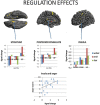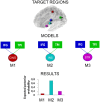Reappraising social emotions: the role of inferior frontal gyrus, temporo-parietal junction and insula in interpersonal emotion regulation
- PMID: 24027512
- PMCID: PMC3759791
- DOI: 10.3389/fnhum.2013.00523
Reappraising social emotions: the role of inferior frontal gyrus, temporo-parietal junction and insula in interpersonal emotion regulation
Abstract
Previous studies have reported the effect of emotion regulation (ER) strategies on both individual and social decision-making, however, the effect of regulation on socially driven emotions independent of decisions is still unclear. In the present study, we investigated the neural effects of using reappraisal to both up- and down-regulate socially driven emotions. Participants played the Dictator Game (DG) in the role of recipient while undergoing fMRI, and concurrently applied the strategies of either up-regulation (reappraising the proposer's intentions as more negative), down-regulation (reappraising the proposer's intentions as less negative), as well as a baseline "look" condition. Results showed that regions responding to the implementation of reappraisal (effect of strategy, that is, "regulating regions") were the inferior and middle frontal gyrus, temporo parietal junction and insula bilaterally. Importantly, the middle frontal gyrus activation correlated with the frequency of regulatory strategies in daily life, with the insula activation correlating with the perceived ability to reappraise the emotions elicited by the social situation. Regions regulated by reappraisal (effect of regulation, that is, "regulated regions") were the striatum, the posterior cingulate and the insula, showing increased activation for the up-regulation and reduced activation for down-regulation, both compared to the baseline condition. When analyzing the separate effects of partners' behavior, selfish behavior produced an activation of the insula, not observed when subjects were treated altruistically. Here we show for the first time that interpersonal ER strategies can strongly affect neural responses when experiencing socially driven emotions. Clinical implications of these findings are also discussed to understand how the way we interpret others' intentions may affect the way we emotionally react.
Keywords: decision-making; interpersonal emotion regulation; mentalizing; social interactions.
Figures





References
-
- Allen J. G., Fonagy P. (2006). Handbook of Mentalization-Based Treatment. Chichester: John Wiley and Sons Ltd
-
- Ashburner J., Friston K. J. (2003). Rigid body transformation, in Human Brain Function eds. Frackowiak R. S., Friston K. J., Frith C., Dolan R. J., Price C., Zeki S., et al. (Oxford, UK: Academic Press; ), 635–654
LinkOut - more resources
Full Text Sources
Other Literature Sources

